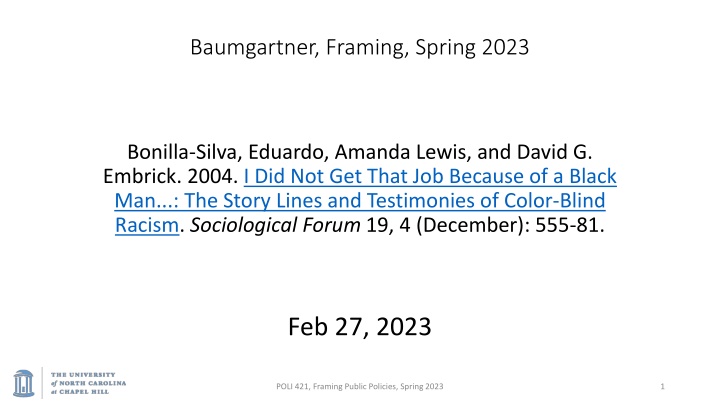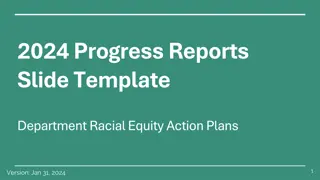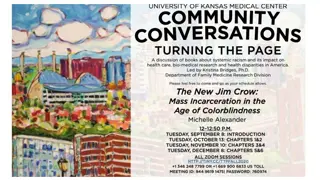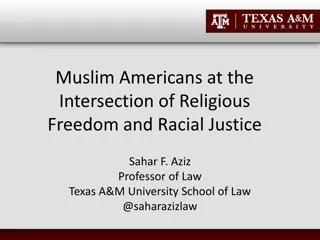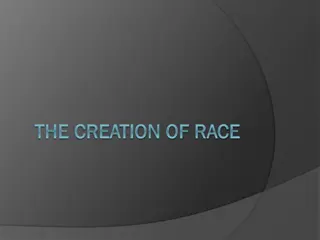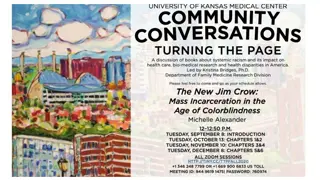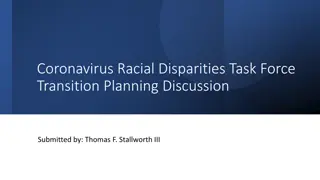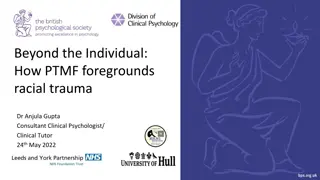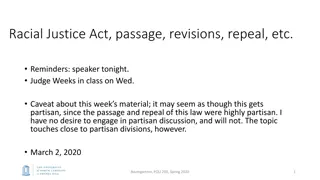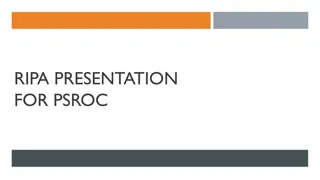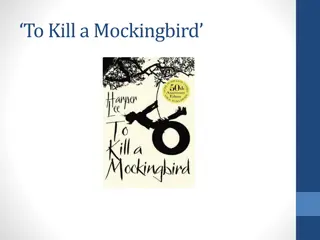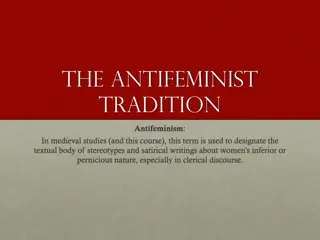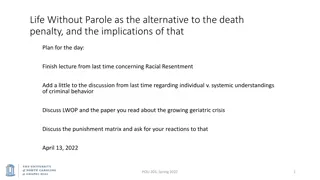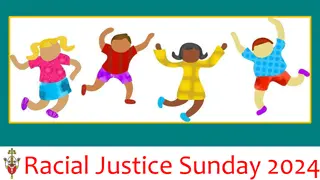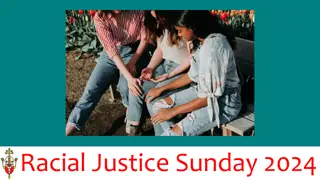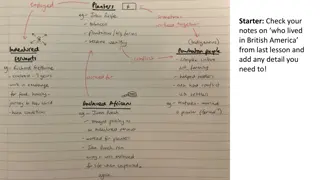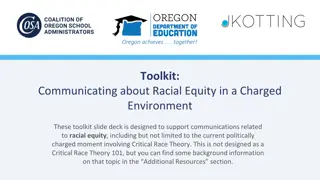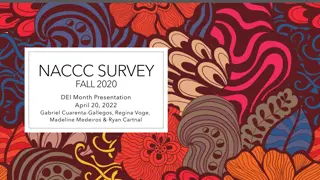Master Racial Stories: Ideological Frameworks in Society
Explore the dominant racial ideologies shaping societies post-civil rights era, focusing on master racial stories, common sense narratives, and fractures within them. Understand the functions of these stories in framing public policies and social identities.
Download Presentation

Please find below an Image/Link to download the presentation.
The content on the website is provided AS IS for your information and personal use only. It may not be sold, licensed, or shared on other websites without obtaining consent from the author.If you encounter any issues during the download, it is possible that the publisher has removed the file from their server.
You are allowed to download the files provided on this website for personal or commercial use, subject to the condition that they are used lawfully. All files are the property of their respective owners.
The content on the website is provided AS IS for your information and personal use only. It may not be sold, licensed, or shared on other websites without obtaining consent from the author.
E N D
Presentation Transcript
Baumgartner, Framing, Spring 2023 Bonilla-Silva, Eduardo, Amanda Lewis, and David G. Embrick. 2004. I Did Not Get That Job Because of a Black Man...: The Story Lines and Testimonies of Color-Blind Racism. Sociological Forum 19, 4 (December): 555-81. Feb 27, 2023 POLI 421, Framing Public Policies, Spring 2023 1
Before we start Additional resources in the library > Library > e-Research > A-Z Database List > News Contains 73 databases, including many individual papers such as NYTimes, Charlotte Observer, the archive of the Associated Press, and so on, often back to the 1800s. Also contains such things as America s News , which has hundreds of papers included, though not as much historical coverage. newspapers.com has many NC newspapers going back in time. Note some of the papers are from overseas, some are African-American or Hispanic papers in the US, and so on. A good resource. POLI 421, Framing Public Policies, Spring 2023 2
OK, on to the topic for today: Race Note: talking about race can be hard, but let s do it. Let s first understand the argument, then discuss. Good that we have many international students in the class. In different countries, there may be different accepted truths based on different identity characteristics. A common theme to think about: social identity theory, with its in- groups and out-groups. Assigning someone to the out-group is what we can call othering. POLI 421, Framing Public Policies, Spring 2023 3
The argument of this article Racial ideology: frameworks or grids that racial groups use to make sense of the world Societies have hierarchies, and the views of the dominant group are more likely to crystallize as common sense One sign that an ideology has gained dominance is that its central logic has come to be perceived as common sense Story lines: socially shared tales that incorporate a common scheme and wording. Like legends or fables, readily available, taken-for- granted. These are generic, not personal. Testimonies: First-hand accounts, not generic stories. POLI 421, Framing Public Policies, Spring 2023 4
Their goals 1. Document the master racial stories of the post-civil rights era 2. Assess the rhetorical and ideological functions of these stories 3. Provide evidence of fractures in these stories Note that many do not embrace these common sense stories (That is, the stories are NOT fully shared by all. They are merely dominant, not completely paradigmatic.) POLI 421, Framing Public Policies, Spring 2023 5
More background Racism v. racial structure Many would refuse to accept the idea that we live in a racist society driven by views of racial hostility and/or hatred. However, it is clear that there is a hierarchical structure; some are on top, some are in a subordinate position. So, we re looking here at racial structures, not necessarily about racism. (Note you could expand this article to be about gender, immigration status, gender orientation, social class, many other domains) POLI 421, Framing Public Policies, Spring 2023 6
Positionality Actors at the top of the hierarchy are more likely to have and express views that help maintain the system, which provides privilege. (Note: More likely to does not mean always exhibit Actors at the bottom are more likely to exhibit opposition and counter-narratives. SO: the point is not that these narratives are true or false. It s that we can use them to understand what is going on. POLI 421, Framing Public Policies, Spring 2023 7
Who are you calling a racist? Many people have a hard time distinguishing between discussions of racialized structures and accusations of personal animus. I ve done lots of talks about police traffic stops where I ve been extremely careful only to talk about statistical disparities but someone who feels defensive about it says that I said that there was racial discrimination or racism on the police force How does motivated reasoning interact with positionality in driving these responses on sensitive subjects. Feel free to substitute race for gender, religion, or another identity-characteristic. POLI 421, Framing Public Policies, Spring 2023 8
Color-blind racism A new and modern justification, not like old-fashioned racism No support for Jim Crow, segregation, etc. But , widespread ideas more subtly associated with race That s the point here, how people promote ideas that support the hierarchical system without sounding like a racist. (Again: easy to apply this to things like why women might not deserve the same wages as men, or whatever.) POLI 421, Framing Public Policies, Spring 2023 9
Data collection 1997 survey of college students in 3 universities (N = 410 whites) 1997 Detroit Area Study (continuing sociological survey of Detroit and suburbs, done by U of M.) (N = 323 whites; 77 blacks) In-depth interviews with 41 of the first group and 83 of the second (66 whites and 17 blacks) In-depth interviews then with 134 respondents form the basis of the study. Not very many black respondents; mostly whites. POLI 421, Framing Public Policies, Spring 2023 10
The Past is the Past Most people used this story-line Two wrongs don t make a right Don t harm whites today for punishment for actions of whites in the past. Reverse discrimination Provides a story line and moral justification for avoiding policies that would subvert the system POLI 421, Framing Public Policies, Spring 2023 11
I didnt own any slaves About one quarter or one-third of the respondents used this story- line Don t make me pay for the sins of people long ago POLI 421, Framing Public Policies, Spring 2023 12
I did not get a job because. One quarter of the students and one third of the DAS respondents used this story line POLI 421, Framing Public Policies, Spring 2023 13
If Jews, Italians, and Irish have made it Only a few raised this issue, but many agreed with a survey question about it. POLI 421, Framing Public Policies, Spring 2023 14
Symbolic Racism Scale (David Sears and PJ Henry, 2002) 7 point scale for each of the following questions, from strongly agree to strongly disagree: Irish, Italians, Jewish, and many other minorities overcame prejudice and worked their way up. Blacks should do the same without any special favors. Generations of slavery and discrimination have created conditions that make it difficult for Blacks to work their way out of the lower class. Over the past few years, Blacks have gotten less than they deserve. It's really a matter of some people not trying hard enough; if Blacks would only try harder they could be just as well off as Whites. A longer version, with instructions, is here: https://condor.depaul.edu/phenry1/SR2Kinstructions.htm Depending on your answers to those four questions, you could get a value from 1 to 28. Then we could use that to predict your attitudes toward other things. It works. (It is falling apart in the current generation now, however. See Candis Smith (UNC public policy) and her new research. POLI 421, Framing Public Policies, Spring 2023 15
The FIRE scale of racial attitudes Agree or disagree with each of the following: I am fearful of people of other races. White people in the U.S. have certain advantages because of the color of their skin. Racial problems in the U.S. are rare, isolated situations. I am angry that racism exists. Source: (Candis Watts Smith, Duke University Political Sciences (formerly UNC Public Policy) and Chris DeSante, Indiana University.) POLI 421, Framing Public Policies 16
A fantastic new article to read Baumgartner, Frank R., Christian Caron, and Scott Duxbury. 2023. Racial Resentment and the Death Penalty. Journal of Race and Ethnic Politics, FirstView, 27 December 2022. We showed that the responses to those questions about racial resentment can be aggregated by state, and over time. Then we showed that, even controlling for ideological conservatism, that scale predicts how many death sentences a state imposes in a given year. More racial resentment, more death sentences. POLI 421, Framing Public Policies, Spring 2023 17
Counter-narratives 15 percent of the students and 12 percent of the DAS group actively counter-argued POLI 421, Framing Public Policies, Spring 2023 18
What is the value of the concept of a story line ? It s a set of frames That support a social hierarchy That have become so widely shared That people take them for granted Even people who disagree with them... Still support them sometimes. However, they are contested and can change over time, or potentially be broken down completely. These story lines reflect and amplify political and social power. So, in your papers, pay attention to this idea. POLI 421, Framing Public Policies, Spring 2023 19
What are the story lines about the following? Women are better suited than men to be teachers, until college The CEO deserves an extremely high salary, compared to the worker Church-goers have good moral values Free speech is the most fundamental form of liberty The police must have the tools they need to keep us safe from danger Felons should not be able to vote Prisoners should work for low wages or no wages at all Poor people are probably responsible for their own predicament, at least in part POLI 421, Framing Public Policies, Spring 2023 20
This article is about race. But what are the story-lines that are common sense about: Women? Individuals with physical disabilities? LGBTQ+ individuals? Old people? College-aged individuals? Southerners? Californians? (Pick your nationality group)? POLI 421, Framing Public Policies, Spring 2023 21
Now the fun part For any story line about a particular identity group: Can you find times and places where it is contested? Can you find that a story line has lost its power over time? Story lines are like hegemonic or dominant frames. But they can degrade or be destroyed over time, if they are replaced by a new one. POLI 421, Framing Public Policies, Spring 2023 22
Current politics question Should a person seeking to be the Democratic nominee for President support reparations for slavery or for the taking of Native American lands? What are the frames for this? What would be the predictable counter-frames? Which one would be advantageous for a candidate? Would a candidate win if they supported reparations? Should that person stand for it anyway? Why did Pres. Obama never do this? Do you think this might ever happen? How would you build momentum to move the Overton window on such a big issue? POLI 421, Framing Public Policies, Spring 2023 23
